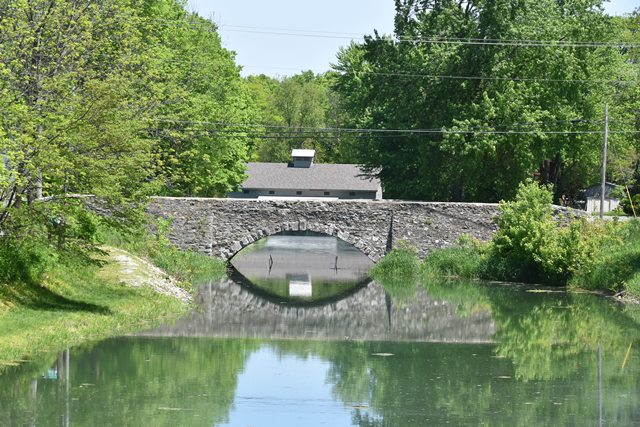We Recommend:
Bach Steel - Experts at historic truss bridge restoration.
BridgeHunter.com Phase 1 is released to the public! - Visit Now
Washington Street Bridge
Carroll County Bridge 2

Primary Photographer(s): Nathan Holth
Bridge Documented: May 19, 2016
Delphi: Carroll County, Indiana: United States
Not Available or Not Applicable
33.5 Feet (10.2 Meters)
113.0 Feet (34.4 Meters)
23.6 Feet (7.19 Meters)
1 Main Span(s)
800001

View Information About HSR Ratings
Bridge Documentation
View Archived National Bridge Inventory Report - Has Additional Details and Evaluation
This bridge is one of two attractive stone arch bridges within eyesight of historic metal truss bridges that have been relocated into Delphi. This combination of historic stone and metal bridges makes Delphi a unique destination for historic bridge enthusiasts, to say nothing of the heritage associated with the Wabash and Erie Canal.
Information and Findings From DHPA Historic Bridge SurveyStatement of Significance Local craftsmen built most of Indiana's stone arches from regional materials just before or in the first fifteen years of the twentieth century. Following a few simple rules of thumb that had evolved since Roman days, stone-masons erected full-centered or semi-circular arches in which the line of pressure passes through the center of each stone in the arch ring until carried vertically into the substructure. Only a few of the state's most stone arches span streams in northern counties. Even before World War I, the growing popularity of concrete, which engineers could readily adjust to the special needs of each specific bridge site, quietly ended most stone arch construction in the state. With a bid for masonry at $3.75 per cubic yard, J. C. O'Connor brought in the lowest and best bid to the Carroll county commissioners in June 1901. O'Connor received payment of $800 on a construction estimate in early December. At the beginning of the next January, he received his final payment for 970 cubic yards of masonry or $3,637.50. In early February, Edward Morrisone won a contract for filling the arch at $.33 per cubic yard. Architectural Description The limestone blocks of the arch ring of this span are roughly cut and mortared. The spandrels, wing-walls, and rails are all of field stone. The structure carries an asphalt roadway and concrete sidewalk to the east between low stone parapet rails. Few of the states arches used field stone in the structure and few have decks as wide. Other Information References Charles J. Ritzler, Bridge Inspection Report: Carroll County (Delphi, 1974-75). Associated Engineering Consultants, Inc., Bridge Reinspection Study and Report: Carroll County (Nashville, 1987). Rumschlag Technical Services, Carroll County Bridge Inventory & Appraisal Report (Brownsburg, 2006). "1901" inscribed on keystone. Indiana State Highway Commission, Bridge Survey, 641 (1933): 20-21; 1243 (1943): 47. Indiana Historic Sites & Structures Inventory, Carroll County: Interim Report (Indianapolis, 1980), 50-51. Carroll County, "Commissioners Record," 20: 454-458, 541, 553, 561. Bridge Considered Historic By Survey: Yes |
![]()
Photo Galleries and Videos: Washington Street Bridge
Bridge Photo-Documentation
Original / Full Size PhotosA collection of overview and detail photos. This gallery offers photos in the highest available resolution and file size in a touch-friendly popup viewer.
Alternatively, Browse Without Using Viewer
![]()
Bridge Photo-Documentation
Mobile Optimized PhotosA collection of overview and detail photos. This gallery features data-friendly, fast-loading photos in a touch-friendly popup viewer.
Alternatively, Browse Without Using Viewer
![]()
Maps and Links: Washington Street Bridge
Coordinates (Latitude, Longitude):
Search For Additional Bridge Listings:
Bridgehunter.com: View listed bridges within 0.5 miles (0.8 kilometers) of this bridge.
Bridgehunter.com: View listed bridges within 10 miles (16 kilometers) of this bridge.
Additional Maps:
Google Streetview (If Available)
GeoHack (Additional Links and Coordinates)
Apple Maps (Via DuckDuckGo Search)
Apple Maps (Apple devices only)
Android: Open Location In Your Map or GPS App
Flickr Gallery (Find Nearby Photos)
Wikimedia Commons (Find Nearby Photos)
Directions Via Sygic For Android
Directions Via Sygic For iOS and Android Dolphin Browser
USGS National Map (United States Only)
Historical USGS Topo Maps (United States Only)
Historic Aerials (United States Only)
CalTopo Maps (United States Only)

